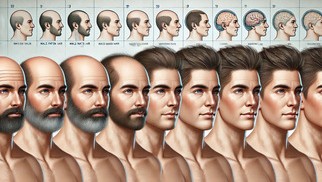Male Pattern Baldness: Causes, Prevalence, and Potential Solutions


Male pattern baldness, also known as androgenetic alopecia, is one of the most common forms of hair loss affecting men worldwide. This condition can have a significant impact on self-esteem and confidence, prompting many to seek answers about its causes, prevalence, and potential solutions. In this article, we delve into the key aspects of male pattern baldness, addressing questions such as whether hair can grow back, how many men are affected, its primary causes, and whether it can be treated effectively.
Can Male Pattern Baldness Grow Back?
The question of whether hair lost to male pattern baldness can grow back is one of the most frequently asked. The answer, however, depends on several factors, including the extent of hair loss and the timing of intervention.
Male pattern baldness occurs due to a progressive shortening of the hair growth cycle. Over time, hair follicles affected by this condition become smaller, producing thinner and shorter hair strands, until they eventually stop producing hair altogether. In the early stages, it is often possible to stimulate hair regrowth using medical treatments or lifestyle changes. For example, medications like minoxidil (a topical treatment) and finasteride (an oral medication) have been approved by the FDA to slow hair loss and, in some cases, promote regrowth.
However, once hair follicles have been dormant for an extended period, regrowth becomes significantly more challenging. Advanced stages of male pattern baldness, characterized by completely bald areas, typically cannot be reversed without surgical interventions such as hair transplantation. Early detection and treatment are therefore critical for the best chances of success.
How Many Men Lose Their Hair by 35?
Male pattern baldness is exceedingly common, with its prevalence increasing significantly with age. By the age of 35, approximately two-thirds of men will experience some degree of noticeable hair loss. By the time they reach 50, about 85% of men will have significantly thinner hair or more extensive baldness.
These statistics highlight the widespread nature of this condition. While genetics play a pivotal role, other factors such as hormonal changes, stress, and lifestyle choices can influence the onset and progression of male pattern baldness. For some men, hair loss begins as early as their late teens or early twenties, emphasizing the importance of early recognition and management.
What Is the Main Cause of Male Pattern Baldness?
The primary cause of male pattern baldness lies in a combination of genetics and hormonal factors. Specifically, this condition is linked to the sensitivity of hair follicles to dihydrotestosterone (DHT), a derivative of testosterone.
DHT is a hormone that plays a crucial role in male development, but it can also adversely affect hair follicles. In individuals predisposed to male pattern baldness, DHT binds to receptors in the scalp, causing hair follicles to shrink and eventually stop producing hair. This process is known as follicular miniaturization.
Genetics determine whether a person’s hair follicles are sensitive to DHT. If male pattern baldness runs in your family, you are more likely to inherit the condition. While it was once believed that the genetic predisposition came solely from the maternal side, we now know that genes from both parents can contribute to the likelihood of developing male pattern baldness.
Other factors, such as poor diet, stress, smoking, and certain medical conditions, can exacerbate hair loss but are not primary causes of androgenetic alopecia. These factors may accelerate the process or make hair loss more noticeable but do not initiate it.
Treatment with Propecia
Propecia, the brand name for finasteride, is one of the most effective and widely used treatments for male pattern baldness. Approved by the FDA, Propecia works by inhibiting the enzyme 5-alpha reductase, which converts testosterone into dihydrotestosterone (DHT). By lowering DHT levels in the scalp, Propecia helps to slow down hair loss and, in many cases, stimulate regrowth.
Clinical studies have shown that Propecia can significantly improve hair density and halt the progression of male pattern baldness in most men who use it consistently. The medication is typically taken as a daily oral tablet and begins to show results within three to six months of continuous use. For optimal results, long-term adherence is essential, as stopping Propecia often leads to a resumption of hair loss within a year.
Propecia is generally well-tolerated, but like any medication, it may cause side effects in some individuals. The most commonly reported side effects include decreased libido, erectile dysfunction, and reduced semen volume. These effects are usually mild and reversible upon discontinuation of the medication. However, it’s important for users to discuss potential risks with their healthcare provider before starting treatment.
Another key consideration with Propecia is its impact on women and children. The medication is not approved for use in women, particularly those who are pregnant or may become pregnant, as it can cause birth defects if absorbed through the skin. For this reason, women are advised to avoid handling broken or crushed Propecia tablets.
Despite these precautions, Propecia remains a cornerstone in the treatment of male pattern baldness. For men seeking to preserve their hair or restore lost density, it offers a convenient and scientifically backed solution. Combining Propecia with other treatments, such as minoxidil or hair transplantation, can further enhance results and provide a comprehensive approach to managing hair loss.
Can You Fix Male Pattern Baldness?
Treating male pattern baldness is a complex process that depends on the individual’s stage of hair loss, overall health, and personal goals. While a complete cure does not yet exist, various options are available to manage and, in some cases, reverse the condition.
Medical Treatments
The most widely used treatments for male pattern baldness are minoxidil and finasteride. Minoxidil is a topical solution or foam applied directly to the scalp. It works by stimulating blood flow to the hair follicles, thereby encouraging hair growth and slowing the progression of hair loss. Finasteride, on the other hand, is an oral medication that inhibits the production of DHT, thereby reducing its effects on hair follicles.
Both treatments require consistent use and may take several months to show results. It is worth noting that stopping these treatments typically results in a resumption of hair loss.
Hair Transplant Surgery
For individuals with advanced hair loss, hair transplant surgery offers a more permanent solution. This procedure involves removing healthy hair follicles from one part of the scalp (usually the back or sides) and transplanting them to areas affected by baldness. Modern techniques, such as follicular unit extraction (FUE) and follicular unit transplantation (FUT), have improved the effectiveness and natural appearance of hair transplants.
While highly effective, hair transplant surgery can be expensive and may not be suitable for everyone. It’s essential to consult a qualified specialist to determine whether you’re a good candidate.
Lifestyle Changes and Non-Medical Approaches
While lifestyle changes alone cannot reverse male pattern baldness, they can help improve overall hair health and slow the progression of hair loss. Maintaining a balanced diet rich in vitamins and minerals, reducing stress through exercise or relaxation techniques, and avoiding smoking can all contribute to healthier hair.
Additionally, cosmetic solutions such as wigs, hairpieces, and scalp micropigmentation can provide effective and non-invasive ways to address hair loss.
Emerging Treatments
Advances in medical research have led to the development of promising new treatments for male pattern baldness. Platelet-rich plasma (PRP) therapy, for instance, involves injecting concentrated platelets from the patient’s own blood into the scalp to stimulate hair growth. Similarly, low-level laser therapy (LLLT) uses light energy to promote cellular activity in hair follicles.
Experimental treatments, including stem cell therapy and gene editing, are also being explored, though these are not yet widely available or fully understood.
Conclusion
Male pattern baldness is a common condition that affects millions of men globally. While its causes are primarily genetic and hormonal, the condition’s impact can be mitigated through early intervention and a variety of treatment options. Although hair lost to advanced stages of male pattern baldness may not grow back naturally, medical treatments, surgical interventions, and lifestyle changes offer viable solutions for managing the condition and restoring confidence.As research continues, the future holds promise for more effective and accessible treatments. For those affected, consulting a healthcare professional is the first step in identifying the most suitable approach to address hair loss and regain control over their appearance and self-esteem.
Article post: Editorial Team of RXShop.md
(Updated at Jan 18 / 2025)

